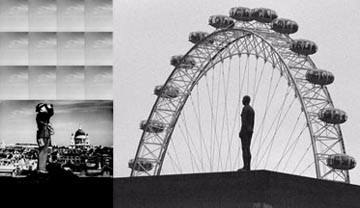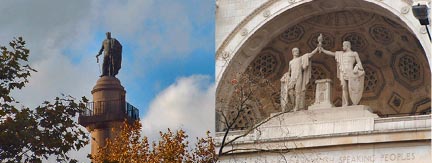Buckingham Guard and Gormley Casting (Photo by Edz, Flickr)
In London, Antony Gormley spreads cast-iron multiples of his own nude body across the skyline near the Hayward Gallery. (At Art Basel Miami last December, I noticed that all the naked people in the artworks were male.) The sculpture is a factual, asexual self-representation without any spirit or energy. It just is.
He uses a pose that mimics the comfortable “attention” posture of the Buckingham Palace guard – a real person playing the role of an interchangeable, repeating generic statue. Both guard and Gormley portrait fail to respond to external stimulation. Human interaction is photographic (take my picture with….) and imaginary like a child imagining a conversation with the doll.

WWII Spotter —-and—– “Event Horizon” (photo by Doctor Boogie, Flickr)
With Gormley, the pictures taken are silhouettes of loneliness in the city with the suggestion of suicide. Although most people have no experience seeing people at the edge of roofs, we have a filmic memory of the suicide waiting to jump. (The BBC TV news story suggests suicide and one flickr photographer transforms it into denial “Art attempts to jump”) As the Flickr photos shows, people capture this lonely moment against the sky with ease.
Gormley might be an expert at creating works that generate an “artistic” photograph among the general public. The vast majority of carefully framed photographs of the stoic figures at both “Another Place” and “Event Horizon” look pretty good. Just line-up the lonely silhouettes against the gray waves or gray skies with a bit of beach or city. No one can take a bad picture of the Angel of the North.
Gormley’s work reveals that contemporary monument is the millions of photographs, not the work itself. To succeed, the work must link psychologically to the generic photographic and filmic memory. Here the actual space plays a role. When in the city plaza surrounded by rooftop figures or on the beach with a 100 figures staring out to sea, our mind sees filmic images of mindless zombies or of cultural hopelessness. Each person shoots with an instinctive camera knowledge that moves back and forth from the pan of mass desperation and to the close-up of individual paralysis.
I guess fortunately the British citizen has the capacity to say “its just art”. But this is denial of a psychological acceptance of depression, loneliness and suicide. In other cultures (and other films) these figures would be in the tomb or standing at the end of the territory to warn or to frighten the outsider. Here the figures surround the Londoner reminding each person of the emptiness of the 21st century life -lonely and with only death as the highest aspiration.

Former Statues of Male Aspiration in London: Duke of Wellington and BCC Building (Photos by Knowledge of London
Event Horizon (GEH) tag on Flickr
Patrick Cates Photos with Long Distance Views
BBC News Story on Event Horizon with Gormley Interview
“Event Horizon” video by Leonardo Tura by music from “Religion” by Phillip Glass.
“Another Place” video by sundaeg1rl with music from ‘Hibiscus on the Water’ by Peter Ware, played by Yvar Mikshoff.
Antony Gormley made 100 cast-iron sculptures from a mould of himself, then planted them firmly in the shoreline at Crosby Beach, Merseyside, gazing out across the sea. How much you can see depends on whether the tide is in or out.
Public Art, Public Space
